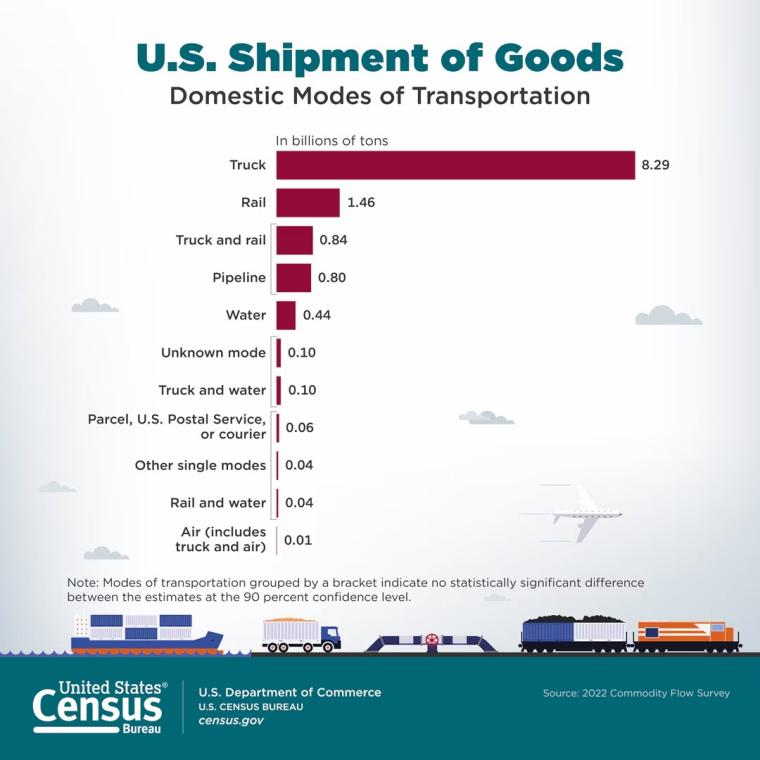
Shipments of goods in the United States reached 12.2 billion tons in 2022, virtually unchanged from 2017, according to the latest Commodity Flow Survey estimates released today by the U.S. Census Bureau. The total value of shipments nationwide over the five-year span increased $3.5 trillion (24.0%) to $18.0 trillion (not adjusted for inflation or seasonality).
Customer Pickup – a newly tabulated mode estimate in 2022 – accounted for 1.4 billion tons of U.S. goods shipped (about 11.4% of the total tonnage) in 2022, valued at $1.0 trillion.
Additional highlights:
- The South region shipped 1.9 billion tons (40.4%) of U.S. goods in 2022, valued at $6.7 trillion. The Midwest followed with 3.4 billion tons (28.1%) of goods shipped, valued at $4.8 trillion.
- Manufacturing establishments shipped 4.9 billion tons of commodities worth $7.1 trillion in 2022. Wholesale establishments shipped 4.1 billion tons of commodities worth $8.1 trillion.
- Trucks as a single domestic mode of transportation hauled approximately 8.3 billion tons (68.1%) of the total tonnage. These shipments accounted for $13.2 trillion (73.5%) of the total value of commodities shipped in 2022.
- An estimated 56.4% of all tonnage traveled less than 50 miles in 2022.
- Trucks carried the largest share (49.6%) of tonnage traveling to Canada.
- Hazardous material shipments weighed 2.6 billion tons and accounted for $2.1 trillion in 2022.
About the Commodity Flow Survey
The Commodity Flow Survey was initiated in 1993 and has been conducted every five years since 1997 as part of the Census Bureau’s economic census. The survey, a partnership with the U.S. Department of Transportation’s Bureau of Transportation Statistics, is the primary source of national, state and selected metropolitan area statistics on domestic freight shipments. It provides information on the origin and destination, value, weight, mode of transportation and distance of commodities shipped.
The CFS provides estimates for the nation, the 50 states and the District of Columbia and selected metropolitan areas.
Policymakers and transportation planners in various federal, state and local agencies use CFS statistics to assess the demand for transportation facilities and services, energy use and safety risk and environmental concerns. A sample of approximately 165,000 establishments are selected based on geographic location and industry.
The Commodity Flow Survey does not include establishments classified in forestry, fishing, utilities, construction, transportation and most retail and services industries. Farms and government-owned entities (except government-owned liquor wholesalers) are also excluded. The survey does not capture information on imports to the United States; however, domestic portions of imported shipments can be included if they pass through a sampled establishment.
Statistics are based on data from the 2022 and 2017 Commodity Flow Surveys and include data only for businesses with paid employees. All dollar values are expressed in current dollars for the period shown, i.e., they are not adjusted for inflation and do not reflect changes in prices. For more information (including definitions and information on comparability, confidentiality protection and sampling and nonsampling error), refer to the Commodity Flow Survey methodology.
All comparisons made in this release have been tested and found to be statistically significant at the 90% confidence level, unless otherwise noted. All estimates include measures of sampling variability.

There are no comments
Please login to post comments